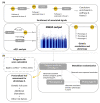Ovarian Physiology and GWAS: Biobanks, Biology, and Beyond
- PMID: 27221566
- PMCID: PMC7610559
- DOI: 10.1016/j.tem.2016.04.011
Ovarian Physiology and GWAS: Biobanks, Biology, and Beyond
Abstract
Ovarian function is central to female fertility, and several genome-wide association studies (GWAS) have been carried out to elucidate the genetic background of traits and disorders that reflect and affect ovarian physiology. While GWAS have been successful in reporting numerous genetic associations and highlighting involved pathways relevant to reproductive aging, for ovarian disorders, such as premature ovarian insufficiency and polycystic ovary syndrome, research has lagged behind due to insufficient study sample size. Novel approaches to study design and analysis methods that help to fit GWAS findings into biological context will improve our knowledge about genetics governing ovarian function in fertility and disease, and provide input for clinical tools and better patient management.
Keywords: menopause; ovarian reserve; polycystic ovary syndrome; premature ovarian insufficiency.
Copyright © 2016 Elsevier Ltd. All rights reserved.
Figures



References
-
- de Bruin JP, et al. The role of genetic factors in age at natural menopause. Hum Reprod. 2001;16:2014–2018. - PubMed
-
- Vink JM, et al. Heritability of polycystic ovary syndrome in a Dutch twin-family study. J Clin Endocrinol Metab. 2006;91:2100–2104. - PubMed
-
- Sadrzadeh S, et al. Birth weight and age at menarche in patients with polycystic ovary syndrome or diminished ovarian reserve, in a retrospective cohort. Hum Reprod. 2003;18:2225–2230. - PubMed
Publication types
MeSH terms
Grants and funding
LinkOut - more resources
Full Text Sources
Other Literature Sources

